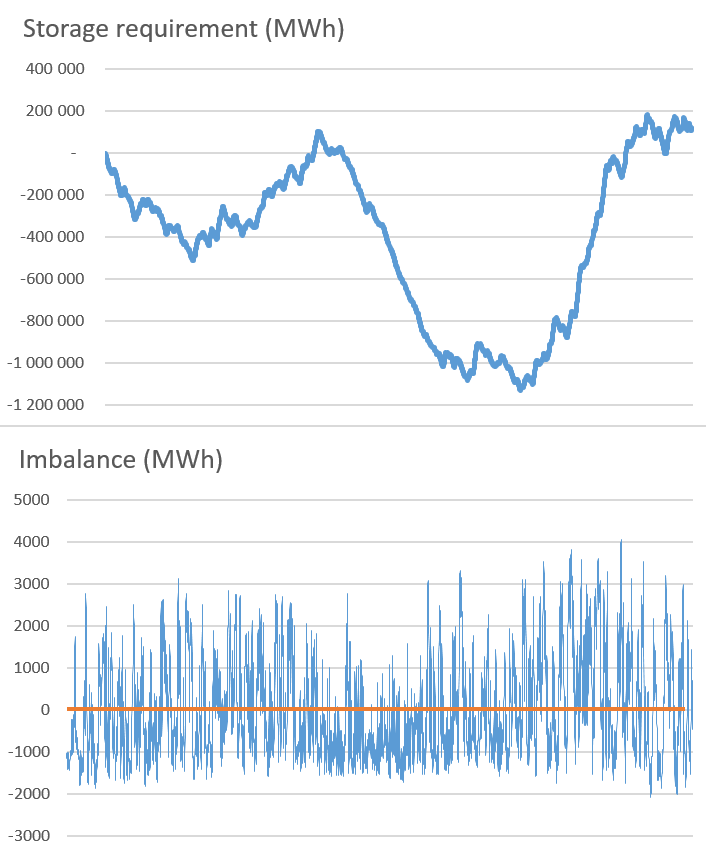Electricity systems are complex and modeling of electricity systems is hard. Every second electricity supply has to exactly match the demand, you have to think about three types of electricity, and, increasingly, about the weather.
Instead of all the complexity, I’ve build a simple model of a country that uses only wind energy to power itself. The model takes into account electricity demand, wind profile, and CAPEX for capital costs of wind power and also energy storage (wind does not blow 24/7). Everything else is not accounted for in any way.
Side note 1: this post is also an attempt to learn Google chart, which is hosted outside of this blog, so chances are that the visuals will not render properly, or at all. Later I’ll try to illustrate visuals with js chart, which can be hosted directly on the blog, but this functionality is outside of my current programming skills.
Side note 2: here is a helpful introductory video explaining units of electricity.
Energy demand is somewhat predictable
First step is to select a country. Let’s go for a moderate climate, located near a sea, mostly service based economy. Let’s say that at any hour in a year such country would need a minimum of 900 MW, and it’s peak load would be around 2200 MW. The name of the country is not important, but it is important that demand and wind profiles are real and pulled from a reputable source. All data is for a full year.
Here’s a graph illustrating consumption profiles on two different days:
Energy consumption is variable in a way that can be reasonably predicted. People usually wake up and start their working days working between 6 and 9, and end most activities by midnight. It’s darker and colder in winter and therefore the country uses more electricity than in the summer. On Sundays electricity demand is “flatter” – people sleep in and don’t go to work (April 18 shown on the graph was on Sunday).
Wind blows as it pleases
Wind is far harder to predict. Long-term average for the year is relatively stable, and it’s clear that in winter storms tend to be most powerful. In general the wind differently each day and does not match electricity demand that well.
In fact, it’s highly unlikely for wind power to exactly match the demand during any hour of any year. In our model year, we have electricity deficit for 60% of the time, and electricity surplus for 40% of the time. In other words, when it blows, it blows hard.
In our hypothetical county in the year we are analyzing, wind on average blows 27% of the time, which is roughly what you would expect for onshore wind for this country.
Installing wind plants
I’ve just realized that the word “plant” is rather apt in the context of making electricity. Real plants (vegetation) convert solar energy to other useful forms of energy, and this is exactly what sun power plants do. Other types of power plants also convert one form of energy into another – and more useful – form of energy: wind plans, gas plants, nuclear plants, etc.
More to the point – when we want to cover all demand with wind power, then the wind power on average should produce what we consume. In our hypothetical country we consume about 12 TWh of electricity, or on average 1400 MW every hour.
To cover this demand with wind power, we would have to install about 1500 large wind turbines distributed across the country (total 5185 MW of installed nominal power). All of that power would cost us about 5,8 billion EUR (1,12 M EUR / MW estimation).
Installing storage
If we go ahead and build that wind, we will need some kind of energy storage, and this storage would have to be able to do two things: (1) power the system when there is no wind; (2) store enough energy so that there is enough when the wind is not strong enough for extended periods of time.
Let’s focus on the storage quantity only. From the graph we can see that we need to store approximately 1 000 000 MWh of energy, which is not that much actually. Depending on the source, at grid scale each MWh could cost from about EUR 10 000 to about EUR 50 000. All of the numbers are very rough, but so is this analysis!
So the storage for our country could be somewhere in the 10-50 billion EUR range. It would be more than all of the wind plants combined!

Admittedly, there are ways to reduce the amount of energy that needs to be stored, or at least to reduce the amount of energy required on tap at any given time.
